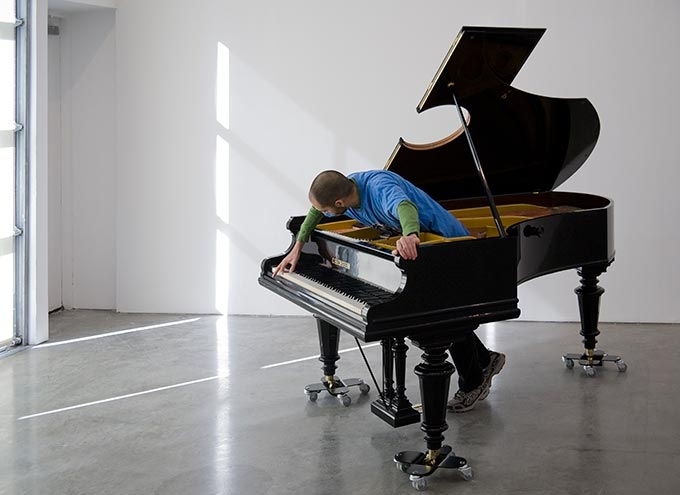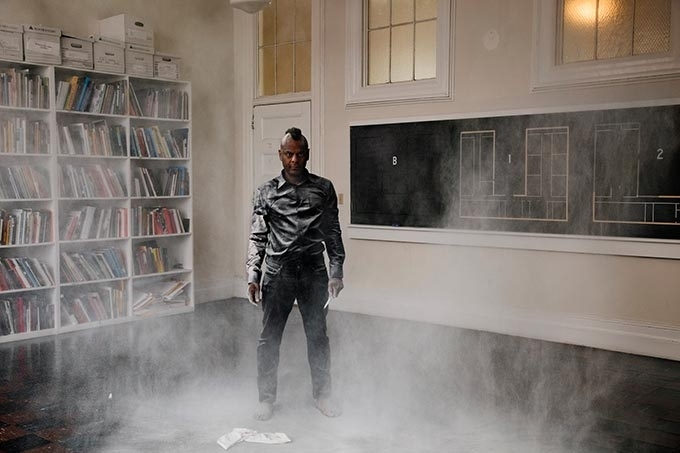Performance Now
–
Middlebury, VT—On Friday, February 7, the Middlebury College Museum of Art will open the exhibition Performance Now, a selection of works by artists who practice a variety of art making procedures featuring videos, objects, films, and installations that document ephemeral occurrences. RoseLee Goldberg, art historian and curator of the exhibit, showed in her groundbreaking book Performance Art: From Futurism To the Present (1979) that performance is central to the history of 20th century art. In 2005 she launched Performa 05, the first biennial of visual art performance, and predicted that performance would become “the medium of the 21st century.” Performance Now deftly demonstrates that this medium’s time has come.

Allora & Calzadilla, Stop, Repair, Prepare, 2009, video documentation on DVD, 24 min., 54 sec. Courtesy of the artists, Gladstone Gallery New York and Brussels, and the Museum of Modern Art, New York.
Performance Now features a preponderance of new performance works created since the year 2000, a period that has witnessed an exponential growth in the field. Bringing together 22 of the most significant practitioners today, the exhibit surveys critical and experimental currents in performance internationally, featuring key Performa commissions, and works by Marina Abramović, Jérôme Bel, Spartacus Chetwynd, William Kentridge, and Clifford Owens, among others.
Together the works in the exhibition are an indication of the extent to which visual artists use performance as part of their creative process; how that process produces objects, installations, video, or photography; and how these mediums have been enlivened by the demands of recording performance in innovative ways. Exploring live performance, artists capture its ephemerality and transform it into new work that contains the power and content of the original.

Clifford Owens, Anthology (Nsenga Knight), 2011, chromogenic-prints. Collection for Sharing and Learning.
With performance art departments being established in many major museums throughout the world, and performance recognized as one of the most significant artistic forms of the 20th century, this exhibition provides a window onto these important developments. There has been much reflection on the complexities of displaying, collecting, preserving, and explaining conceptual material that so profoundly shaped artistic developments in the final decades of the 20th century, yet, paradoxically, was ephemeral. At the same time, contemporary performance is activating museums, drawing new and young audiences to these institutions around the world.
In addition to installations in the museum’s Christian A. Johnson Gallery, there will be regular screenings of films on Thursday evenings at 7:30 p.m. in Room 232 of the Donald F. Axinn Center. Visit the museum’s Web site, museum.middlebury.edu, for a complete and up-to-date list of the Thursday night screenings.

ternational” src=”/media/view/1138/original/ici_logo.jpg” border=”0” width=”81” height=”55” />

225/original/performa_logo.png” border=”0” width=”173” height=”55” />
Performance Now is a traveling exhibition produced by Independent Curators International (ICI), New York, and Performa, New York. The curator for the exhibition is RoseLee Goldberg, Artistic Director and founder of Performa. The exhibition and tour are made possible, in part, by grants from the Horace W. Goldsmith Foundation, and the Andy Warhol Foundation for the Visual Arts; the ICI Board of Trustees; and donors to ICI’s Access Fund. At Middlebury the exhibit is supported by funds from the Christian A. Johnson Memorial Foundation.
Related Events
[view:events==177569/1071] [view:events==177570/1075] [view:events==177570/1072]
Video Screenings
In addition to the works installed in the museum, Performance Now includes a series of films and videos by eleven internationally acclaimed artists. The regular Thursday evening screenings are on campus in Room 232 in the Axinn Center at Starr Library. Additional information about each video will be made available here shortly, so you may want to bookmark this page and visit often. You can also download a PDF schedule of the screenings (2MB).
FEBRUARY
Thursday, February 13, 7:30 pm
Nathalie Djurberg and Hans Berg, Untitled (Working Title: Kids and Dogs), 33 min., 2007
Swedish artist Nathalie Djurberg is best known for her “claymation” films: stop-action, animated cartoons using clay puppets. In this film an army of children on the streets of a large city is at war with a pack of dogs. The second scene takes place in a hospital where the wounded have been brought for treatment. Throughout the film one hears the beat of a bass drum played by two live drummers in military marching band costumes. In addition, the sounds of crunching cereal and squeaking dog toys accompany the images of marching children, crying patients, and firing machine guns.
Laurie Simmons, The Music of Regret, 40 min., 2006
A mini-musical in three acts, this video reflects Simmons’s photographic work. Colorful puppets enact the dissention between two families over a job promotion. In lyrics written by Simmons, Meryl Streep and a male dummy sing romantic duets about the failure of communication and attachment. In the final act, inanimate objects—a gun, a house, and a pocket watch embodied by Alvin Ailey 2 dancers—perform passionately for auditions. The New Yorker credited Simmons for making “a film about the inevitable post-Warhol art-world nexus of irony, finance, and glamour.”
Thursday, February 20, 7:30 pm
Claire Fontaine, Situations, 35 min., 2011
Situations offers a droll series of lessons on self-defense: How to repel surprise knife attacks and bar confrontations as well as other forms of man-to-man street fighting tactics are demonstrated. The information may not be of great use to art crowd viewers, but the entertainment value offsets the dread.
Regina José Galindo, ¿Quién Puede Borrar las Huellas? [Who can erase the traces?], 38 min., 2003
A young woman in a black dress walks barefoot through the streets of Guatemala City. Carrying a basin filled with blood, she stops occasionally, puts down her burden, and steps into it. As she continues on her way she leaves footprints to invoke the spirits of thousands of victims of Guatamala’s brutal civil war.
MARCH
Thursday, March 6, 7:30 pm
Jérôme Bel, Véronique Doisneau, 32 min., 2009
In this extraordinary film we meet Véronique Doisneau, a 42-year-old corps de ballet dancer who is soon to retire from the Paris Opéra Ballet. From the darkened stage of this magnificent facility, which we enter from its grand facade, Doisneau discusses her career, her family, and a few of the memorable roles she has danced—including Giselle and Swan Lake. In a deceptively understated but immensely affecting series of reflections, she illuminates her life as a dancer. In this film, choreographer Jérôme Bel provides his audience “space to move into the most tender, broad, and complex corners of human experience.”
Jesper Just, No Man is an Island, 2002, Bliss and Heaven, 2005, It Will All End In Tears, 2006, and A Voyage In Dwelling, 2008, (total 32 min.)
Jesper Just’s films, heavily influenced by film noir aesthetics, are moody, atmospheric narratives often comprised of ambiguous and unresolved storylines. Just employs social and cinematic conventions to weave together motifs such as power and redemption into films that are both mysterious and intimate.
Kalup Linzy, Conversations with de Churen II: All My Churen, 29 min., 2003
The New York Times’ Holland Cotter writes, “Television soap opera is Mr. Linzy’s primary, though not sole, inspiration. And this particular melodrama, with its Byzantine subplots, revolves around the tortured emotional life of a voluble young woman named Nucuazia and the death of an acquaintance named JoJo, whom we take to be her lover, in a drive-by shooting. The story has oodles of intrigue (not to mention loose ends), heartbreak aplenty (crying jags culminating in a confrontational, cathartic memorial service) and at least one major surprise… . If most of the characters, including Nucuazia’s sharp-tongued mother, soft-touch grandmother, wastrel brother and brusque corporate executive sister, share an uncanny family resemblance, it is because Mr. Linzy plays them all, brilliantly.”
Thursday, March 13, 7:30 pm
Ryan Trecartin, A Family Finds Entertainment, 42 min., 2004
In A Family Finds Entertainment, the video that brought him to public view, the loose narrative involves a disturbed and disturbing black-toothed kid named Skippy (played by Mr. Trecartin) who borrows money from his parents, is filmed by a documentary filmmaker, is hit by a car, then filmed again as he lies in the road, and whose soul seems to rise from his body when it hears the sounds of a rocking house party.
Nandipha Mntambo, Ukungenisa, 2 min., 30 sec., 2003
“Ukungenisa—the mental and physical preparation for a fight, and the opening of a path to allow something to happen—captures the artist literally rehearsing the steps of a bullfighter whom she filmed in Lisbon, juxtaposed with footage of the fight and the crowd of spectators. This attempt to take on the persona of the bullfighter represents a shift for Mntambo, whose previous work effectively invited the viewer to take her place, to step into the outline of her body as defined by the molded cowhide.”—Stevenson Gallery
Contains material for mature audiences.
Thursday, March 20, 7:30 pm
Nandipha Mntambo, Ukungenisa, 2 min., 30 sec., 2003
“Ukungenisa—the mental and physical preparation for a fight, and the opening of a path to allow something to happen—captures the artist literally rehearsing the steps of a bullfighter whom she filmed in Lisbon, juxtaposed with footage of the fight and the crowd of spectators. This attempt to take on the persona of the bullfighter represents a shift for Mntambo, whose previous work effectively invited the viewer to take her place, to step into the outline of her body as defined by the molded cowhide.”—Stevenson Gallery
Liz Magic Laser, I Feel Your Pain, 80 min., 2011
APRIL
Thursday, April 3, 7:30 pm
Laurie Simmons, The Music of Regret, 40 min., 2006
A mini-musical in three acts, this video reflects Simmons’s photographic work. Colorful puppets enact the dissention between two families over a job promotion. In lyrics written by Simmons, Meryl Streep and a male dummy sing romantic duets about the failure of communication and attachment. In the final act, inanimate objects—a gun, a house, and a pocket watch embodied by Alvin Ailey 2 dancers—perform passionately for auditions. The New Yorker credited Simmons for making “a film about the inevitable post-Warhol art-world nexus of irony, finance, and glamour.”
Nathalie Djurberg and Hans Berg, Untitled (Working Title: Kids and Dogs), 33 min., 2007
Swedish artist Nathalie Djurberg is best known for her “claymation” films: stop-action, animated cartoons using clay puppets. In this film an army of children on the streets of a large city is at war with a pack of dogs. The second scene takes place in a hospital where the wounded have been brought for treatment. Throughout the film one hears the beat of a bass drum played by two live drummers in military marching band costumes. In addition, the sounds of crunching cereal and squeaking dog toys accompany the images of marching children, crying patients, and firing machine guns.
Thursday, April 10, 7:30 pm
Jérôme Bel, Véronique Doisneau, 32 min., 2009
In this extraordinary film we meet Véronique Doisneau, a 42-year-old corps de ballet dancer who is soon to retire from the Paris Opéra Ballet. From the darkened stage of this magnificent facility, which we enter from its grand facade, Doisneau discusses her career, her family, and a few of the memorable roles she has danced—including Giselle and Swan Lake. In a deceptively understated but immensely affecting series of reflections, she illuminates her life as a dancer. In this film, choreographer Jérôme Bel provides his audience “space to move into the most tender, broad, and complex corners of human experience.”
Ryan Trecartin, A Family Finds Entertainment, 42 min., 2004
In A Family Finds Entertainment, the video that brought him to public view, the loose narrative involves a disturbed and disturbing black-toothed kid named Skippy (played by Mr. Trecartin) who borrows money from his parents, is filmed by a documentary filmmaker, is hit by a car, then filmed again as he lies in the road, and whose soul seems to rise from his body when it hears the sounds of a rocking house party.
Thursday, April 17, 7:30 pm
Regina José Galindo, ¿Quién Puede Borrar las Huellas? [Who can erase the traces?], 38 min., 2003
A young woman in a black dress walks barefoot through the streets of Guatemala City. Carrying a basin filled with blood, she stops occasionally, puts down her burden, and steps into it. As she continues on her way she leaves footprints to invoke the spirits of thousands of victims of Guatamala’s brutal civil war.
Nandipha Mntambo, Ukungenisa, 2 min., 30 sec., 2003
“Ukungenisa—the mental and physical preparation for a fight, and the opening of a path to allow something to happen—captures the artist literally rehearsing the steps of a bullfighter whom she filmed in Lisbon, juxtaposed with footage of the fight and the crowd of spectators. This attempt to take on the persona of the bullfighter represents a shift for Mntambo, whose previous work effectively invited the viewer to take her place, to step into the outline of her body as defined by the molded cowhide.”—Stevenson Gallery
Claire Fontaine, Situations, 35 min., 2011
Situations offers a droll series of lessons on self-defense: How to repel surprise knife attacks and bar confrontations as well as other forms of man-to-man street fighting tactics are demonstrated. The information may not be of great use to art crowd viewers, but the entertainment value offsets the dread.
